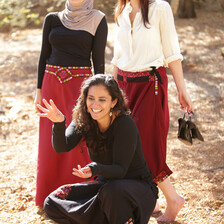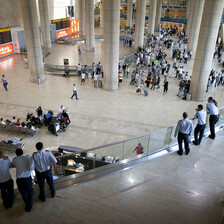The Electronic Intifada Tarshiha 30 October 2014

Tarshiha village was destroyed by Israeli war planes in October 1948.
APA imagesOn Friday, 24 October, the village of Tarshiha in the upper western Galilee region of present-day Israel commemorated its fall to Zionist forces during the Nakba. Palestinians marked remembrance of the forced expulsion from their homeland in the late 1940s, in an event that they call Yom Tarshiha (Tarshiha Day).
Yom Tarshiha has become an important day on the calendar for Palestinians in the Galilee. Nizar Hawari, one of the local Tarshiha Day organizers (and this reporter’s aunt), explained that the annual event is an attempt to make sure that the new generation in Tarshiha remembers the village’s history through the sharing and passing on of historical narratives.
“Tarshiha is special,” she said. “It is an example of what happened to Palestine as a whole. Remembering what happened to our village is also important because time is running out for the older generation. We need to make sure their stories do not die with them.”
The village was subjected to aerial bombardment and relentless artillery barrage on 28 October 1948. Many homes and buildings were destroyed and dozens of people were killed. By 1 November, most of the villagers had been forced to flee their homes into neighboring countries.
According to historian Ilan Pappe in his seminal work The Ethnic Cleansing of Palestine, the order was given by the Zionist forces to “clear” Tarshiha.
However some of the villagers remained close by to the village and were eventually allowed back to settle. They suffered under a brutal military regime throughout the 1950s and until the mid-60s, during which the Palestinian narrative of what happened in 1948 was actively suppressed and ignored. Those who remained — and their descendants — now live as second-class citizens in Israel.
Today, the village has a population of approximately 5,000 including both Muslims and Christians. It is encircled by Jewish Israeli towns which are encroaching on their land and trying to marginalize the Palestinian identity of the village.
Reviving oral history
Local documentary filmmaker Basel Tannous explained to The Electronic Intifada that the Zionist founding fathers expected that the old generation of Palestinians would eventually die and that the new generation would forget their history. “So we must make sure that they don’t forget,” he said.
Over the last two decades, there has been an increased effort to revive oral history in Palestine in a counter-struggle against the Zionist hegemonic narrative. Commemorative activities such as Yom Tarshiha are part of that revival effort.
The academic revival has also been particularly strong with projects at the Center for Palestine Studies at Columbia University in New York City and the Palestine oral history archive at Birzeit University near the occupied West Bank city of Ramallah.
This year, Yom Tarshiha began with tours of the village and storytelling by the first generation of survivors of the Nakba. The tours were particularly aimed at the children of the village and focused on Palestinian life before 1948.
The main event kicked off with a candle-lit march through Tarshiha led by the village elders and prominent Palestinian figures such as Haneen Zoabi, a member of Israel’s parliament, the Knesset. The march ended in a square where there were speeches, poems, songs and dancing against a picturesque backdrop of olive tree groves.
Poignant
The women of Tarshiha played a particularly prominent role this year in the commemorative event. Yara Bishara, a young Palestinian from the village, sang the popular song “Bride of the Galilee,” and locally renowned visual artist Rana Bishara painted a mural of an olive tree in the heart of the village. Among its branches, she wrote the 150 family names of Tarshiha’s residents both now and before 1948.
A particularly poignant speech was given by Cecile Kahli, also an artist from Tarshiha, who reminded the crowd of the village’s descendants in the refugee camps in Lebanon, Syria, Jordan and elsewhere. She also emphasized Tarshiha’s mixed population of Muslims and Christians and how the two communities do not distinguish between their religious differences.
The audience was varied and many people from neighboring villages attended. Nizar Hawari explained that “Tarshiha is a symbol for the Nakba. People want to feel Palestinian; they want to participate in something that is not for the Israeli state.”
Land confiscation
Yom Tarshiha was commemorated against a historical backdrop of land confiscations in the village. In 1963, the neighboring Israeli town of Maalot annexed Tarshiha and declared that the two communities would share a municipality.
Most residents of Tarshiha saw this as a move to gain control over Tarshiha’s historic land. Permission to build is frequently denied to Palestinian residents. At the same time, land is often taken from the village to make way for further housing for Jewish Israelis.
Hawari explained that it is not only about strangling the village. It is also about challenging the Palestinian identity and destroying the sense of community within Palestinian villages.
“Families cannot expand here, they have to move somewhere else. Somewhere where there is more land. So in this way people are splitting up and moving,” she said, adding that “Even on our ID cards it doesn’t say Tarshiha. It says Maalot Tarshiha.”
Atmosphere of repression
In addition to the land confiscations, the event also took place within an atmosphere of increasing repression of Palestinian freedom of expression inside Israel.
The nearby community of Iqrit, destroyed by Israel in 1948, frequently holds cultural events in the ruins of its village. For the last several years, young activists have been trying to maintain a continuous presence in the village.
This summer, Israeli police raided the village, uprooting trees and confiscating community belongings. The police also violently arrested three activists and detained them in the local police station.
This year, Israeli police made their presence known at Yom Tarshiha by parking their vehicle indiscreetly at the rally and monitoring the participants. A young participant named Ayman said to The Electronic Intifada, “Let them watch, we don’t care.”
The younger generation in the Galilee are becoming more outspoken in their political activities. Although this year’s event wasn’t the largest Yom Tarshiha ever held, activists say that it drew the largest number of young people than any other year.
It is this generation that many Palestinians feel will bring about a sea change in the oppressive Zionist regime.
Yara Hawari is a British Palestinian freelance writer. She is a PhD candidate at the University of Exeter and a research fellow at the Kenyon Institute in occupied East Jerusalem, where she lives and works.





